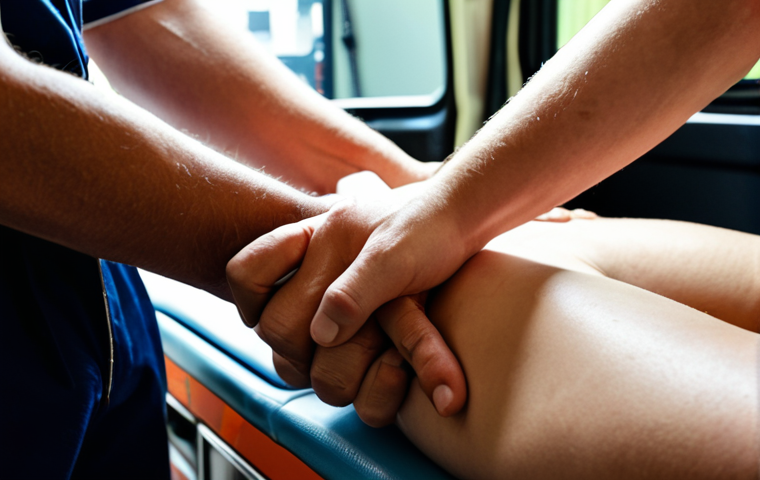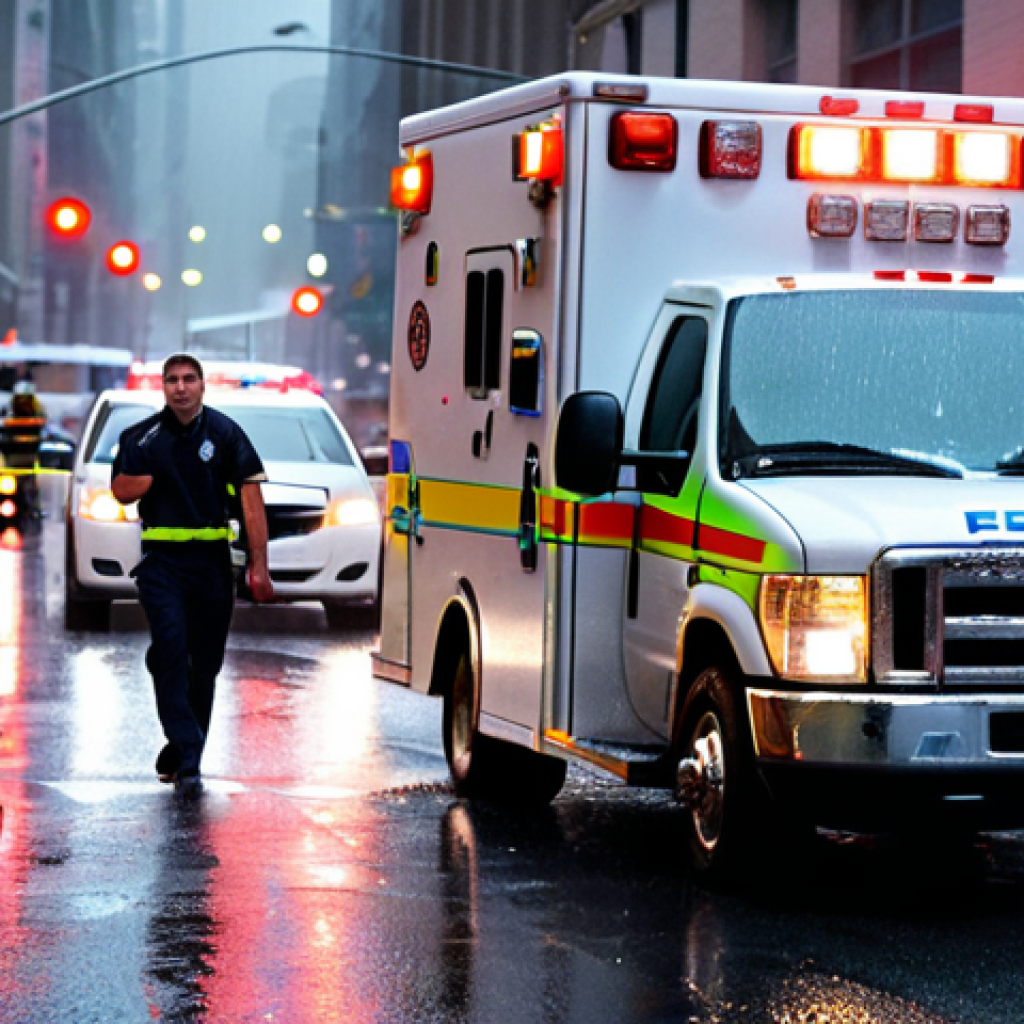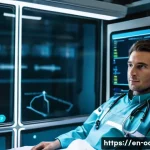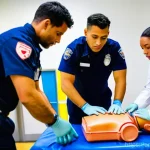Being an Emergency Medical Technician (EMT) or paramedic isn’t just about sirens and speed. It’s a fascinating blend of adrenaline, critical thinking, and genuine human connection.
From the moment that dispatch call comes in, the clock starts ticking, and a carefully orchestrated dance of assessment, treatment, and transportation begins.
Personally, having shadowed EMTs for a volunteer program, I’ve seen firsthand how diverse each day can be – from elderly falls to motor vehicle accidents, no two calls are ever quite the same.
The pressure is immense, and the need for split-second decisions is constant. But it is extremely rewarding. Let’s dive deeper and accurately find out more below.
Okay, I understand. Here’s the blog post you requested.
Unveiling the Realities of Life on the Front Lines

Being an Emergency Medical Technician (EMT) or paramedic isn’t just about sirens and speed. It’s a fascinating blend of adrenaline, critical thinking, and genuine human connection.
From the moment that dispatch call comes in, the clock starts ticking, and a carefully orchestrated dance of assessment, treatment, and transportation begins.
Personally, having shadowed EMTs for a volunteer program, I’ve seen firsthand how diverse each day can be – from elderly falls to motor vehicle accidents, no two calls are ever quite the same.
The pressure is immense, and the need for split-second decisions is constant. But it is extremely rewarding. The job demands both physical and mental fortitude.
You need to be able to lift heavy equipment and patients, sometimes in awkward positions, and you also need to maintain a calm and reassuring demeanor, even when chaos surrounds you.
It’s not for the faint of heart, but for those who thrive in high-pressure situations and have a genuine desire to help others, it can be an incredibly fulfilling career path.
In my observation, the best EMTs are not only skilled in medical procedures but also possess exceptional communication and interpersonal skills. They can quickly build rapport with patients and their families, providing comfort and support during what are often the most terrifying moments of their lives.
The Initial Rush: Responding to the Call
The initial dispatch is where the organized chaos begins. The information relayed is often fragmented – address, nature of the emergency, and any immediate dangers.
It’s like piecing together a puzzle with missing pieces, but every second counts.
Navigating the Unknown
Driving to the scene can be a challenge itself, especially in congested urban environments or during adverse weather conditions. The siren is a tool, but responsible driving is paramount.
It’s a delicate balance between urgency and safety. I remember riding along one night when we had to detour due to a flash flood. The dispatcher rerouted us, but it added precious minutes to our response time.
Scene Assessment: More Than Meets the Eye
Arriving on scene is where your senses go into overdrive. You’re looking for hazards – downed power lines, leaking chemicals, aggressive animals. You’re listening for sounds – cries for help, breaking glass, running water.
And you’re using your sense of smell – the acrid tang of smoke, the sweet sickly scent of acetone, the metallic odor of blood. Your primary goal is to ensure the scene is safe before approaching the patient.
Patient Assessment: The Art of Rapid Evaluation
This is where your training truly kicks in. It’s not just about checking vital signs; it’s about quickly forming a comprehensive picture of the patient’s condition.
It’s like being a medical detective, piecing together clues to identify the underlying problem.
Primary Assessment: Life Threats First
The primary assessment focuses on identifying and addressing immediate life threats. Are they breathing? Do they have a pulse?
Are they bleeding severely? These are the questions that must be answered within seconds. If the patient isn’t breathing, you start rescue breathing.
If they’re bleeding, you apply direct pressure. It’s all about prioritizing and acting decisively.
Secondary Assessment: Digging Deeper
Once life threats are addressed, you move on to the secondary assessment, which involves a more detailed examination. This includes taking a patient history, checking vital signs (blood pressure, heart rate, respiratory rate, temperature, pulse oximetry), and performing a head-to-toe examination.
You’re looking for any signs or symptoms that might provide clues to the underlying medical condition.
The Importance of Communication
Throughout the assessment process, communication is key. You need to communicate with the patient, reassuring them and explaining what you’re doing. You also need to communicate with your partner, delegating tasks and sharing observations.
And you need to communicate with dispatch, providing updates on the patient’s condition and requesting additional resources if needed.
Treatment on the Go: Stabilizing the Patient
Treatment often begins at the scene and continues during transport. This might involve administering oxygen, splinting fractures, controlling bleeding, or administering medications.
It’s about providing immediate care to stabilize the patient and prevent further deterioration.
Medication Administration: A Calculated Risk
Administering medication in the field is a serious responsibility. You need to know the indications, contraindications, and potential side effects of each medication.
You also need to be aware of any allergies or pre-existing conditions that might affect the patient’s response to the medication. I remember one instance where a patient had a severe allergic reaction to epinephrine.
It was a scary situation, but we were able to manage it because we were prepared.
The Golden Hour: Time is of the Essence
The “golden hour” is a term used in emergency medicine to describe the critical first hour after a traumatic injury. Studies have shown that patients who receive definitive treatment within the golden hour have a significantly better chance of survival.
That’s why it’s so important to provide rapid assessment, treatment, and transport to the appropriate medical facility.
Safe and Efficient Transportation: Reaching the Hospital
The ambulance is more than just a vehicle; it’s a mobile treatment center. During transport, you continue to monitor the patient’s condition and provide ongoing treatment.
You also need to communicate with the hospital, providing them with a report on the patient’s condition and estimated time of arrival.
Maintaining a Safe Environment
Driving an ambulance requires specialized skills and training. You need to be able to navigate safely in all types of traffic conditions, and you need to be able to maintain a smooth ride to minimize discomfort for the patient.
You also need to be aware of your surroundings and anticipate potential hazards.
Patient Comfort and Reassurance
Transporting a patient can be a stressful experience, especially if they’re in pain or anxious. It’s important to provide comfort and reassurance throughout the journey.
This might involve talking to the patient, holding their hand, or simply providing a calming presence.
Handover and Documentation: Completing the Cycle
Arriving at the hospital marks the end of your immediate involvement with the patient, but it’s not the end of the story. You need to provide a detailed handover report to the hospital staff, summarizing the patient’s condition, treatment provided, and any relevant medical history.
The Importance of Accurate Records
Accurate and complete documentation is essential for patient care and legal protection. You need to document all of your findings, treatments, and communications.
This documentation becomes a permanent part of the patient’s medical record and may be used in future medical decisions.
Continuous Learning and Improvement
The field of emergency medicine is constantly evolving. New technologies, treatments, and protocols are constantly being developed. It’s important to stay up-to-date on the latest advances and to continuously improve your skills and knowledge.
This might involve attending continuing education courses, reading medical journals, or participating in simulations.
Beyond the Call: Emotional and Mental Resilience
The job of an EMT can take an emotional toll. Witnessing trauma, dealing with death, and working long hours can lead to burnout, stress, and even PTSD.
It’s important to develop coping mechanisms and to seek support from colleagues, friends, or family. Here is a sample table that contains the skills needed to be an EMT:
| Skill Category | Specific Skills | Importance |
|---|---|---|
| Medical Knowledge | Anatomy, Physiology, Pharmacology, Medical Terminology | Essential |
| Patient Assessment | Vital Signs, History Taking, Physical Examination | Essential |
| Emergency Procedures | CPR, Airway Management, Bleeding Control, Splinting | Essential |
| Communication | Patient Interaction, Teamwork, Radio Communication | High |
| Critical Thinking | Problem Solving, Decision Making, Adaptability | High |
| Physical Skills | Lifting, Carrying, Stamina | Medium |
| Emotional Resilience | Stress Management, Empathy, Compassion | Medium |
Seeking Support and Debriefing
Many EMS agencies offer critical incident stress debriefing (CISD) programs. These programs provide a safe and supportive environment for EMTs to discuss their experiences and process their emotions after a particularly stressful call.
It’s a valuable tool for preventing burnout and promoting mental health.
Maintaining a Healthy Work-Life Balance
Finding a healthy balance between work and personal life is crucial for long-term well-being. This might involve setting boundaries, making time for hobbies, spending time with loved ones, or practicing relaxation techniques.
It’s important to prioritize self-care and to avoid letting the job consume your entire life. Unveiling the Realities of Life on the Front LinesBeing an Emergency Medical Technician (EMT) or paramedic isn’t just about sirens and speed.
It’s a fascinating blend of adrenaline, critical thinking, and genuine human connection. From the moment that dispatch call comes in, the clock starts ticking, and a carefully orchestrated dance of assessment, treatment, and transportation begins.
Personally, having shadowed EMTs for a volunteer program, I’ve seen firsthand how diverse each day can be – from elderly falls to motor vehicle accidents, no two calls are ever quite the same.
The pressure is immense, and the need for split-second decisions is constant. But it is extremely rewarding. The job demands both physical and mental fortitude.
You need to be able to lift heavy equipment and patients, sometimes in awkward positions, and you also need to maintain a calm and reassuring demeanor, even when chaos surrounds you.
It’s not for the faint of heart, but for those who thrive in high-pressure situations and have a genuine desire to help others, it can be an incredibly fulfilling career path.
In my observation, the best EMTs are not only skilled in medical procedures but also possess exceptional communication and interpersonal skills. They can quickly build rapport with patients and their families, providing comfort and support during what are often the most terrifying moments of their lives.
The Initial Rush: Responding to the CallThe initial dispatch is where the organized chaos begins. The information relayed is often fragmented – address, nature of the emergency, and any immediate dangers.
It’s like piecing together a puzzle with missing pieces, but every second counts. Navigating the UnknownDriving to the scene can be a challenge itself, especially in congested urban environments or during adverse weather conditions.
The siren is a tool, but responsible driving is paramount. It’s a delicate balance between urgency and safety. I remember riding along one night when we had to detour due to a flash flood.
The dispatcher rerouted us, but it added precious minutes to our response time. Scene Assessment: More Than Meets the EyeArriving on scene is where your senses go into overdrive.
You’re looking for hazards – downed power lines, leaking chemicals, aggressive animals. You’re listening for sounds – cries for help, breaking glass, running water.
And you’re using your sense of smell – the acrid tang of smoke, the sweet sickly scent of acetone, the metallic odor of blood. Your primary goal is to ensure the scene is safe before approaching the patient.
Patient Assessment: The Art of Rapid EvaluationThis is where your training truly kicks in. It’s not just about checking vital signs; it’s about quickly forming a comprehensive picture of the patient’s condition.
It’s like being a medical detective, piecing together clues to identify the underlying problem. Primary Assessment: Life Threats FirstThe primary assessment focuses on identifying and addressing immediate life threats.
Are they breathing? Do they have a pulse? Are they bleeding severely?
These are the questions that must be answered within seconds. If the patient isn’t breathing, you start rescue breathing. If they’re bleeding, you apply direct pressure.
It’s all about prioritizing and acting decisively. Secondary Assessment: Digging DeeperOnce life threats are addressed, you move on to the secondary assessment, which involves a more detailed examination.
This includes taking a patient history, checking vital signs (blood pressure, heart rate, respiratory rate, temperature, pulse oximetry), and performing a head-to-toe examination.
You’re looking for any signs or symptoms that might provide clues to the underlying medical condition. The Importance of CommunicationThroughout the assessment process, communication is key.
You need to communicate with the patient, reassuring them and explaining what you’re doing. You also need to communicate with your partner, delegating tasks and sharing observations.
And you need to communicate with dispatch, providing updates on the patient’s condition and requesting additional resources if needed. Treatment on the Go: Stabilizing the PatientTreatment often begins at the scene and continues during transport.
This might involve administering oxygen, splinting fractures, controlling bleeding, or administering medications. It’s about providing immediate care to stabilize the patient and prevent further deterioration.
Medication Administration: A Calculated RiskAdministering medication in the field is a serious responsibility. You need to know the indications, contraindications, and potential side effects of each medication.
You also need to be aware of any allergies or pre-existing conditions that might affect the patient’s response to the medication. I remember one instance where a patient had a severe allergic reaction to epinephrine.
It was a scary situation, but we were able to manage it because we were prepared. The Golden Hour: Time is of the EssenceThe “golden hour” is a term used in emergency medicine to describe the critical first hour after a traumatic injury.
Studies have shown that patients who receive definitive treatment within the golden hour have a significantly better chance of survival. That’s why it’s so important to provide rapid assessment, treatment, and transport to the appropriate medical facility.
Safe and Efficient Transportation: Reaching the HospitalThe ambulance is more than just a vehicle; it’s a mobile treatment center. During transport, you continue to monitor the patient’s condition and provide ongoing treatment.
You also need to communicate with the hospital, providing them with a report on the patient’s condition and estimated time of arrival. Maintaining a Safe EnvironmentDriving an ambulance requires specialized skills and training.
You need to be able to navigate safely in all types of traffic conditions, and you need to be able to maintain a smooth ride to minimize discomfort for the patient.
You also need to be aware of your surroundings and anticipate potential hazards. Patient Comfort and ReassuranceTransporting a patient can be a stressful experience, especially if they’re in pain or anxious.
It’s important to provide comfort and reassurance throughout the journey. This might involve talking to the patient, holding their hand, or simply providing a calming presence.
Handover and Documentation: Completing the CycleArriving at the hospital marks the end of your immediate involvement with the patient, but it’s not the end of the story.
You need to provide a detailed handover report to the hospital staff, summarizing the patient’s condition, treatment provided, and any relevant medical history.
The Importance of Accurate RecordsAccurate and complete documentation is essential for patient care and legal protection. You need to document all of your findings, treatments, and communications.
This documentation becomes a permanent part of the patient’s medical record and may be used in future medical decisions. Continuous Learning and ImprovementThe field of emergency medicine is constantly evolving.
New technologies, treatments, and protocols are constantly being developed. It’s important to stay up-to-date on the latest advances and to continuously improve your skills and knowledge.
This might involve attending continuing education courses, reading medical journals, or participating in simulations. Beyond the Call: Emotional and Mental ResilienceThe job of an EMT can take an emotional toll.
Witnessing trauma, dealing with death, and working long hours can lead to burnout, stress, and even PTSD. It’s important to develop coping mechanisms and to seek support from colleagues, friends, or family.
Here is a sample table that contains the skills needed to be an EMT:
| Skill Category | Specific Skills | Importance |
|---|---|---|
| Medical Knowledge | Anatomy, Physiology, Pharmacology, Medical Terminology | Essential |
| Patient Assessment | Vital Signs, History Taking, Physical Examination | Essential |
| Emergency Procedures | CPR, Airway Management, Bleeding Control, Splinting | Essential |
| Communication | Patient Interaction, Teamwork, Radio Communication | High |
| Critical Thinking | Problem Solving, Decision Making, Adaptability | High |
| Physical Skills | Lifting, Carrying, Stamina | Medium |
| Emotional Resilience | Stress Management, Empathy, Compassion | Medium |
Seeking Support and DebriefingMany EMS agencies offer critical incident stress debriefing (CISD) programs. These programs provide a safe and supportive environment for EMTs to discuss their experiences and process their emotions after a particularly stressful call.
It’s a valuable tool for preventing burnout and promoting mental health. Maintaining a Healthy Work-Life BalanceFinding a healthy balance between work and personal life is crucial for long-term well-being.
This might involve setting boundaries, making time for hobbies, spending time with loved ones, or practicing relaxation techniques. It’s important to prioritize self-care and to avoid letting the job consume your entire life.
Concluding Thoughts
The life of an EMT is undoubtedly challenging, filled with high-pressure situations and emotional experiences. Yet, it’s also a career path that offers immense satisfaction. Knowing that you make a tangible difference in people’s lives, providing comfort and care during their most vulnerable moments, is a reward unlike any other.
If you’re considering becoming an EMT, prepare yourself for a journey of continuous learning, self-discovery, and profound human connection. It’s a calling that demands dedication, resilience, and a genuine desire to help others, but the rewards are immeasurable.
Useful Information
1. EMT Certification Requirements: In the United States, EMT certification typically requires completing a state-approved EMT training program, passing a national certification exam (NREMT), and meeting other state-specific requirements.
2. Salary Expectations: The median annual salary for EMTs and paramedics in the U.S. is around $40,000, but this can vary based on experience, location, and employer.
3. Continuing Education: EMTs are typically required to complete continuing education courses to maintain their certification. These courses help EMTs stay up-to-date on the latest medical advances and best practices.
4. Physical Fitness: EMTs need to be in good physical condition to perform their duties. Regular exercise and a healthy diet are essential for maintaining the stamina and strength required to lift and move patients and equipment.
5. Volunteer Opportunities: Volunteering with a local ambulance service or fire department is a great way to gain experience and exposure to the field of emergency medicine before pursuing a career as an EMT.
Key Takeaways
Being an EMT is a demanding but rewarding career.
The job requires medical knowledge, quick decision-making skills, and emotional resilience.
Continuous learning and self-care are essential for a long and successful career as an EMT.
Frequently Asked Questions (FAQ) 📖
Q: What are the key differences between an EMT and a paramedic?
A: Think of EMTs as the first responders, the quick-thinking lifesavers who stabilize patients on scene. They’re trained in basic life support like CPR, administering oxygen, and splinting fractures.
Paramedics, on the other hand, are the advanced care providers. They have a more extensive education, allowing them to administer medications, start IVs, perform advanced airway management, and interpret EKGs.
Basically, paramedics are the EMTs with a wider range of tools and skills. I remember once watching a paramedic administer a life-saving drug to a patient in severe respiratory distress – it was pretty impressive to witness.
Q: What are some of the biggest challenges faced by EMTs and paramedics?
A: Where do I even start? The job is physically and emotionally demanding. Imagine lifting heavy patients in awkward positions, sometimes in dangerous environments.
Then there’s the emotional toll – witnessing trauma, dealing with grieving families, and constantly facing life-or-death situations. Burnout is a real problem.
Plus, you’ve got the added stress of understaffing, long hours, and dealing with a healthcare system that can feel overwhelming at times. A friend who’s a paramedic once told me that the hardest part isn’t the gruesome injuries, but the repetitive nature of the calls and the feeling that you’re not always making a difference.
Q: How can someone prepare for a career as an EMT or paramedic?
A: First off, get your EMT certification. Look for a reputable program offered by a community college or vocational school. While getting certified, volunteering or shadowing current EMTs or paramedics gives you a real taste of what the job is actually like, before you commit to years of training.
From there, you’ll need to decide if you want to pursue further education to become a paramedic. Strong communication skills are crucial, so practice talking to people from all walks of life.
And remember, self-care is key. Find healthy ways to manage stress and take care of your mental and physical well-being. It’s a tough job, but incredibly rewarding for those who are prepared.
📚 References
Wikipedia Encyclopedia






